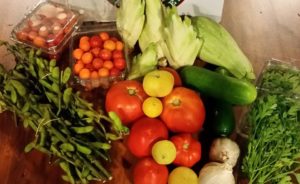 There are a small number of vegetables that are challenging to preserve. Lettuce comes to mind – it is so delicate, and composed so largely of water, that it looses its character when preserved. We recommend eating lettuce when it’s fresh! Most vegetables, however, can be preserved in a number of ways, including canning, freezing, and drying. Similarly, most vegetables can be transformed into your favorite pickles, jams, and other dishes and then preserved via canning and freezing.
There are a small number of vegetables that are challenging to preserve. Lettuce comes to mind – it is so delicate, and composed so largely of water, that it looses its character when preserved. We recommend eating lettuce when it’s fresh! Most vegetables, however, can be preserved in a number of ways, including canning, freezing, and drying. Similarly, most vegetables can be transformed into your favorite pickles, jams, and other dishes and then preserved via canning and freezing.
As you no doubt know, it’s important to be aware of food safety issues, including when you are preserving vegetables. In addition, there are variations in some methods of preserving – for instance, will you dry your vegetables in a dehydrator, in the oven, or using the sun? For these reasons, we want to refer you to the experts for instructions on various methods of preservation. Here are some links to useful sites:
For canning: Iowa State University (ISU) Extension and Outreach offers a downloadable guide to canning.
For freezing: Similarly, ISU Extension and Outreach offers a guide for freezing.
For drying: The Penn State Extension offers instructions for drying.
And the National Center for Home Food Preservation offers instructions for pretty much every way of preserving food!
We know a lot of you are really busy, and for that reason, we recommend becoming familiar with the process for freezing vegetables, because freezing them is quick and easy. Review freezing instructions from ISU Extension and/or the National Center for Home Food Preservation. The basic, generic steps for freezing vegetables are:
1. Prepare your vegetables by washing them and removing damaged leaves, trimming off roots and stems, etc.
2. Cut your vegetables into whatever kinds of pieces you want (i.e., chopped, sliced, grated, etc.) Some vegetables, such as tomatoes and hot peppers, can be frozen whole.
3. Blanch your vegetables in boiling water or steam.
4. Immediately cool your vegetables by plunging them into an ice water bath.
5. Drain the vegetables well, and/or dry them (depending on the vegetable).
6. Pack into containers and freeze!
In addition, in order to create convenience for yourself later, consider processing your vegetables a little bit before freezing them. Some vegetables, such as herbs, spinach, carrots, etc. are incredibly useful if you cook them, purée them, and then freeze them. When you want to make a smoothie or soup or something later, you can just grab some of your frozen purée and throw it in! Freezing purées in ice cube trays makes them particularly simple to use (after your purée cubes are frozen, remove them from the tray and store them in the freezer in bags or containers).
Similarly, you can freeze prepared foods such as vegetable casseroles, roasted vegetables, and preserves (think freezer jam). Having these on hand can make life a lot easier on busy days!